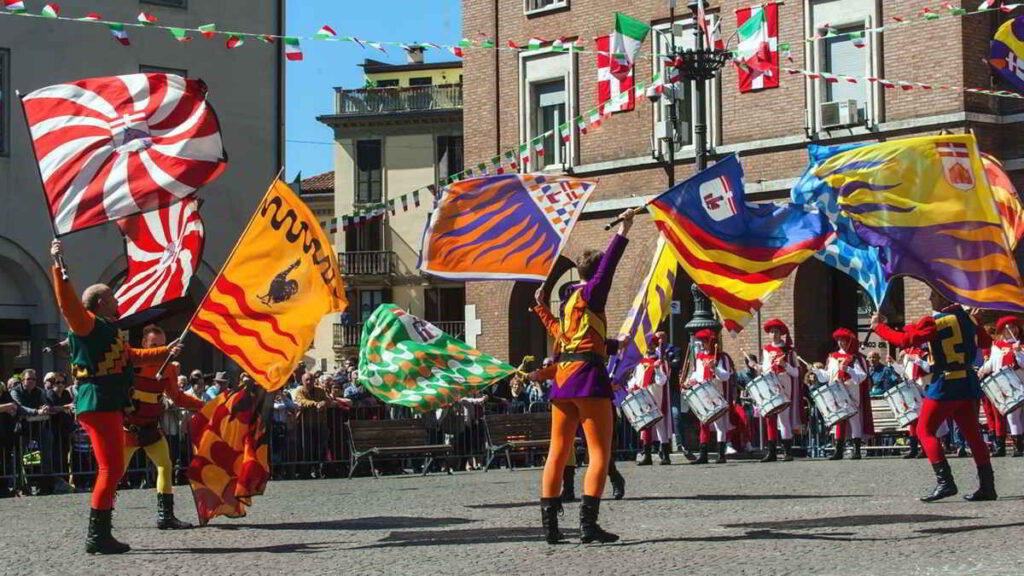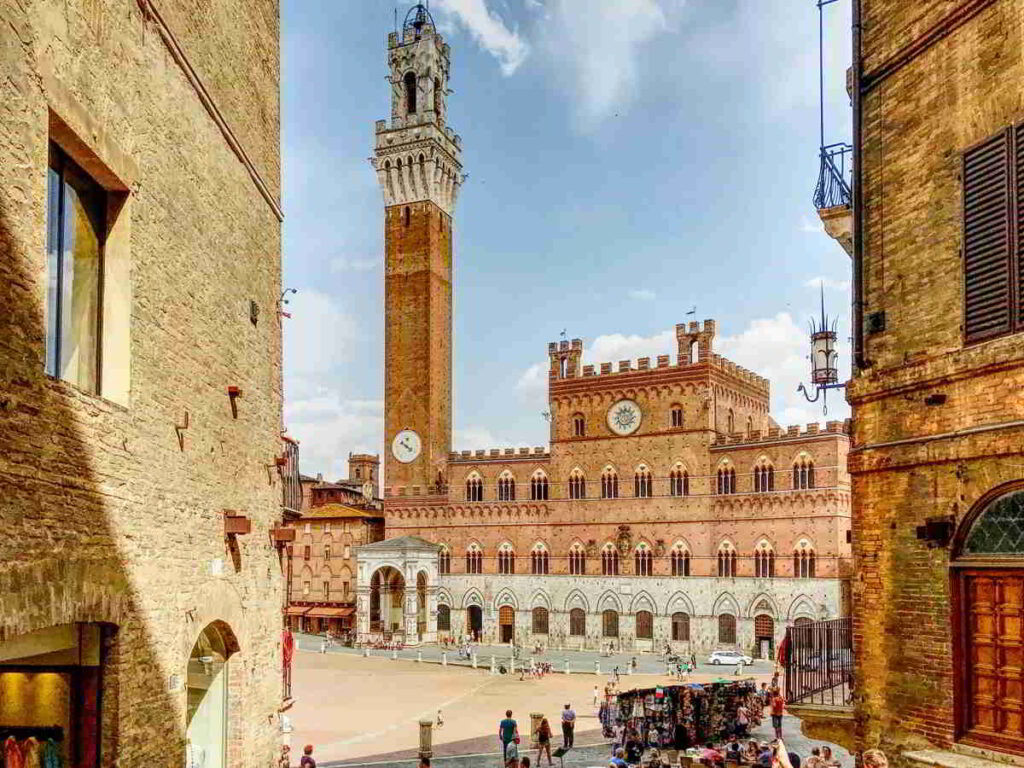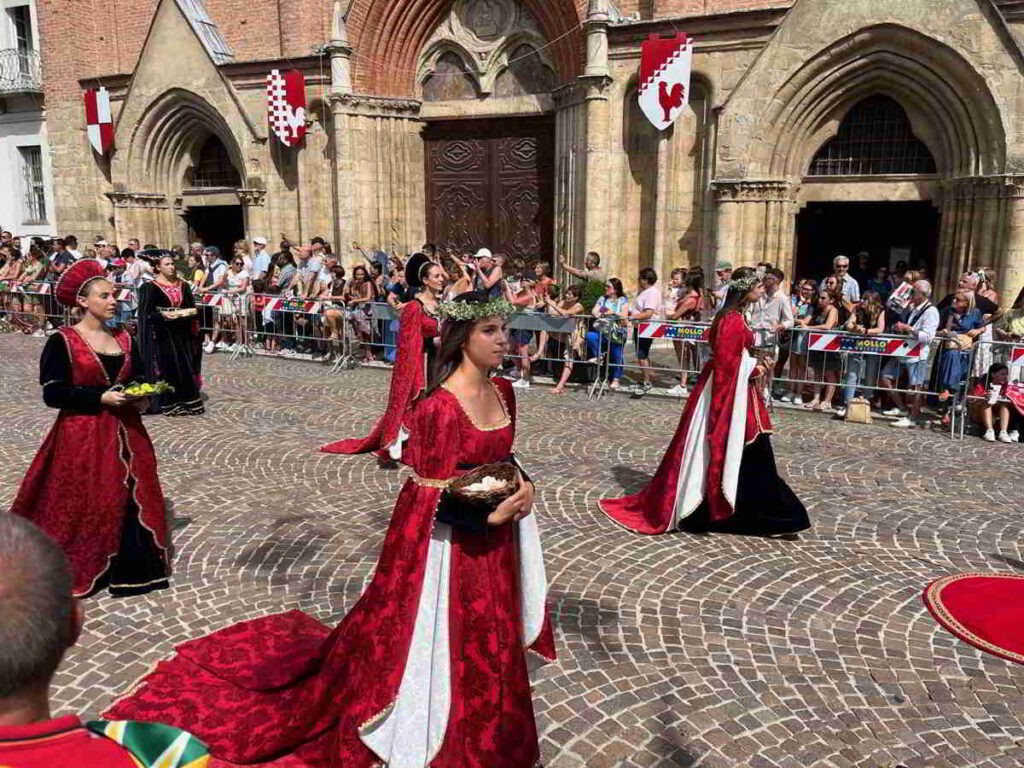Asti Italy Tourism offers a unique blend of rich history, exquisite wines, and vibrant cultural events, making it an ideal destination for travelers seeking an authentic Italian experience. SIXT.VN provides comprehensive travel solutions to ensure a seamless visit to Asti and other captivating destinations in Italy. Discover the charm of Asti with our expert travel guidance, exceptional accommodation options, and convenient transportation services, enhancing your Italian adventure with unforgettable memories and unparalleled ease.
1. What Are the Key Differences Between Siena and Asti’s Palio Horse Races?
The Palio horse races in Siena and Asti, Italy, are both historic events featuring vibrant reenactments, but they differ significantly in their origins, settings, and customs. Siena’s Palio, rooted in a long-standing rivalry with Florence, takes place in the medieval charm of the Piazza del Campo and honors the Virgin Mary, while Asti’s Palio, set in the heart of Piedmont’s wine region, has ancient origins tied to local rivalries and celebrates San Secondo, the city’s patron saint. Both races involve bareback horse racing among city districts, but Siena’s is more internationally recognized, and Asti’s focuses more on historical pageantry and local traditions. According to the Piedmont Regional Tourism Board, Asti’s Palio attracts over 20,000 visitors each year, highlighting its significance in the region’s cultural landscape.
1.1 How Do the Origins of Siena and Asti’s Palio Horse Races Differ?
The origins of the Palio horse races in Siena and Asti are distinct due to different historical contexts and documentation. Asti claims to host Italy’s oldest Palio, with the earliest reference appearing in a 1275 document, celebrating a victory over Alba, while Siena’s first documented Palio horse race is recorded in 1633, although earlier documents mention a Palio in honor of San Bonifazio. This difference in historical record reflects the unique development of each city and its traditions. As noted by the University of Siena’s historical archives, the Palio in Siena evolved from earlier forms of public celebrations, while Asti’s Palio originated from medieval military exercises.
1.2 How Do the Settings for Asti and Siena’s Palio Differ?
The settings for Asti and Siena’s Palio horse races differ significantly, reflecting the unique urban landscapes of each city. Siena’s Palio takes place in the shell-shaped Piazza del Campo, a medieval square with an incline and sharp turns, while Asti’s Palio is held in Piazza Alfieri, a flat square with sharp turns surrounded by 19th-century Piedmontese architecture. These contrasting settings provide distinct challenges and visual experiences for the races. According to architectural historian Giuseppe Sergi, the Piazza del Campo’s unique layout contributes to the excitement and unpredictability of the Siena Palio.
1.3 How Do the Customs of Asti and Siena’s Palio Differ?
The customs surrounding Asti and Siena’s Palio horse races differ significantly, encompassing unique traditions and rituals. Siena’s Palio features intense rivalries, strategic maneuvering, and a focus on the horse’s victory, while Asti’s Palio adopts a more generous approach with multiple prizes and emphasizes historical pageantry and local celebrations. These differences in customs reflect the distinct cultural identities of each city. Research from the Italian Cultural Heritage Ministry indicates that Siena’s Palio is deeply intertwined with the city’s social fabric, while Asti’s Palio serves as a showcase for Piedmontese heritage.
 Asti
Asti
Alt: Asti Palio Flags: Historic flag throwers perform in Asti’s Palio, celebrating city’s vibrant cultural heritage
2. What is the Historical Significance of the Palio Horse Race?
The Palio is a traditional Italian bareback horse race between city districts, deriving from the Latin term “pallium,” meaning “cloth” or “banner,” which serves as the prize. Originating in medieval times as competitions among city districts to determine the most powerful area, the Palio evolved into a symbolic representation of communal pride and local heritage. This historical significance is deeply intertwined with the cities’ identities, reflecting the resilience and spirit of their people. According to a study by the University of Florence, the Palio in both Siena and Asti highlights the enduring importance of local traditions in Italy.
2.1 How Did the Palio Evolve from Medieval Competitions?
The Palio evolved from medieval competitions among city districts that served to determine the most powerful areas and document alliances and rivalries. As cities were protected by defensive walls, residents near specific sections were summoned to assist during attacks, leading to competitions to showcase strength and unity. Over time, these competitions transformed into the Palio horse race, symbolizing communal pride and local heritage. Research from the Italian Historical Society indicates that these medieval competitions were crucial in shaping local identities and fostering community spirit.
2.2 What Role Did the Palio Play in Demonstrating Power and Prestige?
In medieval times, the Palio served as a means of demonstrating power and prestige among the noble families of Siena and Asti. The race provided a platform for showcasing wealth, influence, and dominance within the community. Winning the Palio was a significant achievement that elevated the status of the victorious district and its leaders. According to historical records from the Siena State Archives, the Palio was often used to assert authority and maintain social order.
2.3 How Does the Palio Reflect Communal Pride and Local Heritage?
The Palio reflects communal pride and local heritage by bringing entire communities together in a celebration of their unique identities. The festivities, including parades, pageantry, and elaborate costumes, showcase the traditions and customs of each district. The Palio serves as a reminder of the cities’ histories and the enduring spirit of their people. Studies by the Piedmont Cultural Association highlight that events like the Palio reinforce local identities and promote cultural preservation.
 Siena
Siena
Alt: Campo Square and Torre del Mangia in Siena: A vibrant photo captures Campo Square and Torre del Mangia during Siena’s Palio, showcasing rich medieval architecture
3. Where Should You Visit in Asti for a Taste of Local Culture?
Asti offers a variety of attractions for tourists seeking to immerse themselves in the local culture, including Piazza Alfieri, the Cattedrale di Santa Maria Assunta, and the Collegiata di San Secondo. These destinations showcase the city’s rich history, architectural beauty, and religious heritage. According to the Asti Tourism Board, these sites are essential for understanding the cultural significance of the city and its traditions.
3.1 Why is Piazza Alfieri Significant to Asti’s Cultural Scene?
Piazza Alfieri is significant to Asti’s cultural scene as the location for the annual Palio horse race and other important civic events. Surrounded by elegant arcades and historic buildings, the square serves as a central gathering place for the community, hosting markets, festivals, and celebrations. Piazza Alfieri embodies the spirit and traditions of Asti. Architectural reviews in “Piedmont History Journal” note the square’s historical and social importance.
3.2 What is the Historical and Architectural Significance of the Cattedrale di Santa Maria Assunta?
The Cattedrale di Santa Maria Assunta holds significant historical and architectural importance as a prime example of Gothic architecture in Piedmont. Constructed in the 14th century, the cathedral features a stunning façade, intricate stained glass windows, and impressive interior artwork. The cathedral represents Asti’s religious heritage. Art historian Elena Montanari describes the cathedral as a masterpiece of medieval craftsmanship.
3.3 How Does the Collegiata di San Secondo Reflect Asti’s Religious Heritage?
The Collegiata di San Secondo reflects Asti’s religious heritage as it is dedicated to the city’s patron saint and houses his relics. The church features a blend of architectural styles, including Romanesque and Baroque elements, reflecting its long history. The Collegiata di San Secondo serves as a spiritual center for the community. Religious scholar Roberto Rossi highlights the church’s role in preserving Asti’s cultural and religious identity.
4. What Are the Preparations and Celebrations Before the Palio Race?
The preparations and celebrations before the Palio race in both Asti and Siena involve elaborate costumes, propitiatory dinners, and the solemn blessing of the horses and riders. These traditions bring the entire community together in a celebration of local heritage and pride. According to cultural anthropologist Maria Bianchi, these pre-race activities are crucial for fostering community spirit and reinforcing cultural values.
4.1 How Do City Districts Prepare Elaborate Costumes and Floats for the Palio?
City districts prepare elaborate costumes and floats for the Palio, investing significant time and resources to showcase their unique identities. Residents volunteer to sew costumes, construct floats, and create banners that reflect their district’s history and symbols. This collaborative effort fosters a sense of unity and pride within each district. Costume designer Giovanni Russo explains that these preparations often begin months in advance, involving meticulous attention to detail.
4.2 What is the Significance of the Blessing Ceremony for Horses and Riders?
The blessing ceremony for horses and riders holds deep spiritual significance in both Asti and Siena. Held in the city’s cathedral or each Contrada’s church, the ceremony invokes divine protection and blessings for the participants. This tradition underscores the reverence with which the Palio is regarded. Religious historian Anna Ferrari notes that the blessing ceremony reflects the deep spiritual connection between the community and the Palio.
4.3 What Role Do Propitiatory Dinners Play in Palio Celebrations?
Propitiatory dinners play a vital role in Palio celebrations, offering a convivial gathering where hundreds of people come together to share food, songs, and camaraderie. Organized by each city district, these dinners foster community spirit and provide an opportunity to celebrate their shared heritage. The food is prepared by volunteers, and joining is usually possible for a fee. Sociologist Paolo Martini explains that these dinners reinforce social bonds and promote a sense of belonging.
 Asti and Siena
Asti and Siena
Alt: Historical Reenactment in Asti’s Palio: This photo shows a vibrant historical reenactment in Asti’s Palio, highlighting intricate costumes and cultural heritage
5. What Unique Traditions are Associated with Asti’s Palio Horse Race?
Asti’s Palio horse race boasts unique traditions, including multiple prizes that decrease in significance and the humorous reward of a salad topped with salted anchovies for the last place. These traditions add character to the event. According to the Piedmont Regional Council, these unique traditions reflect the region’s history and cultural identity.
5.1 How Does Asti’s Prize System Differ from Siena’s?
Asti adopts a more generous approach by offering multiple prizes that decrease in significance, while Siena’s strict rules leave no room for second-place celebrations. The second place receives a bag of silver coins, the third gets spurs, and then there’s a live rooster—a symbol of the medieval free Commune—and a cockade. The last place earns a salad topped with salted anchovies. Historian Marco Lombardi notes that this reflects different cultural values.
5.2 What is the Significance of Awarding a Live Rooster as a Prize?
Awarding a live rooster as a prize symbolizes the medieval free Commune and the region’s agricultural heritage. The rooster represents vitality, courage, and the spirit of independence. This tradition harkens back to a time when livestock played a central role in daily life. Ethnobotanist Giulia Romano explains that the rooster is a symbol of rural traditions and self-sufficiency.
5.3 Why is a Salad Topped with Salted Anchovies Awarded to the Last Place?
A salad topped with salted anchovies is awarded to the last place as a humorous reward that carries historical significance. For a long time, salted anchovies were the only available sea fish in Piedmont and served as natural flavor enhancers. This tradition provides a lighthearted conclusion to the race. Food historian Antonio Rizzo explains that the anchovy salad reflects the region’s culinary history and resourcefulness.
6. How Do the City Districts Compete in Asti’s Palio Horse Race?
In Asti, twenty-one contenders, comprising fourteen Rioni from the city and seven from surrounding towns, compete in the Palio horse race. The race lasts most of the afternoon since not all horses can compete simultaneously, consisting of three groups of seven horses each. In the fourth race, the three winners from the earlier heats face off in the final competition. According to the Asti City Council, this format ensures that all districts have a fair chance to compete.
6.1 How Many Districts Participate in Asti’s Palio?
Twenty-one contenders participate in Asti’s Palio, comprising fourteen Rioni from the city and seven from surrounding towns scattered around the province. These districts represent various neighborhoods and communities within the Asti region. The large number of participants reflects the widespread interest in the Palio. Statistician Luca Moretti notes that this high level of participation contributes to the Palio’s cultural significance.
6.2 How is the Race Structured to Accommodate All Participants?
The race is structured into three groups of seven horses each, with a fourth race where the three winners from the earlier heats face off in the final competition. This format allows all twenty-one districts to compete, ensuring a fair and engaging event. The gradual progression of the race builds excitement. Event organizer Chiara Martini explains that this structure is designed to maximize participation and engagement.
6.3 What Role Do Surrounding Towns Play in Asti’s Palio Competition?
Surrounding towns play a significant role in Asti’s Palio competition by contributing seven of the twenty-one contenders. These towns bring their unique traditions and local pride to the event, enriching the cultural tapestry of the Palio. Their participation underscores the regional importance of the Palio. Historian Paolo Goria explains that the inclusion of surrounding towns reinforces regional identity.
7. What Considerations Should You Keep in Mind When Planning Your Visit to Asti for the Palio?
When planning your visit to Asti for the Palio, consider booking accommodations and transportation well in advance, familiarize yourself with the Palio schedule, and respect local customs and traditions. These considerations will help ensure a smooth and enjoyable experience. According to the Piedmont Tourism Association, careful planning is essential for making the most of your Palio visit.
7.1 How Far in Advance Should You Book Accommodations and Transportation?
You should book accommodations and transportation several months in advance, as the Palio attracts a large number of visitors. Hotels, guesthouses, and transportation options tend to fill up quickly, so early planning is crucial. Booking early also allows you to secure better rates and availability. Travel agent Marco Visconti recommends booking at least six months in advance to ensure the best options.
7.2 Where Can You Find the Official Schedule and Details of the Palio?
You can find the official schedule and details of the Palio on the Asti City Council website and local tourism information centers. These sources provide accurate and up-to-date information on the Palio events, including race times, parade routes, and related festivities. Consulting official sources ensures that you have the most reliable information. Event coordinator Laura Rossi emphasizes the importance of checking official sources for the latest details.
7.3 How Can You Show Respect for Local Customs and Traditions During the Palio?
You can show respect for local customs and traditions during the Palio by dressing appropriately, avoiding disruptive behavior, and participating respectfully in the festivities. Learning a few basic Italian phrases and demonstrating an interest in local culture can also enhance your experience. Respecting local customs fosters positive interactions. Cultural ambassador Elena Martini suggests engaging with locals respectfully and showing appreciation for their traditions.
 Asti in Italy
Asti in Italy
Alt: Touring Asti Italy: Snapshot of touring Asti, Italy, captures medieval architecture and vibrant city life
8. Beyond the Palio, What Other Attractions Does Asti Offer?
Beyond the Palio, Asti offers a wealth of other attractions, including the charming historic center, the renowned Asti wine region, and various cultural events and festivals. These attractions provide diverse experiences for visitors. According to the Asti Tourist Office, the city’s rich history and cultural heritage make it a destination worth exploring.
8.1 What Historical Sites Can You Visit in Asti’s Historic Center?
In Asti’s historic center, you can visit numerous historical sites, including the Torre Troyana, the Palazzo Alfieri, and the Baptistery of San Pietro. These landmarks showcase the city’s rich medieval heritage and architectural beauty. Exploring these sites offers a glimpse into Asti’s past. Architectural historian Giovanni Lombardi describes these sites as testaments to Asti’s historical significance.
8.2 How Can You Explore the Renowned Asti Wine Region?
You can explore the renowned Asti wine region by visiting local vineyards, participating in wine-tasting tours, and learning about the production of Asti Spumante and other regional wines. Many vineyards offer guided tours and tastings, providing an immersive experience. Discovering the Asti wine region is a treat for wine enthusiasts. Enologist Isabella Conti recommends visiting family-run wineries for an authentic experience.
8.3 What Cultural Events and Festivals Take Place in Asti Besides the Palio?
Besides the Palio, Asti hosts various cultural events and festivals, including the Festival delle Sagre, the Asti Film Festival, and numerous food and wine events. These events celebrate local traditions, cuisine, and artistic expression. Attending these events offers opportunities to experience Asti’s vibrant cultural scene. Event planner Alessandro Rossi notes that these festivals attract visitors from around the world.
9. How Can SIXT.VN Enhance Your Tourism Experience in Asti, Italy?
SIXT.VN can enhance your tourism experience in Asti, Italy, by providing comprehensive travel solutions such as personalized travel itineraries, convenient airport transfer services, a variety of hotel options, and expertly guided tours. SIXT.VN ensures a smooth and enjoyable trip. According to customer reviews, SIXT.VN’s services are highly praised for their reliability and convenience.
9.1 How Can SIXT.VN Help With Personalized Travel Itineraries?
SIXT.VN can help with personalized travel itineraries by tailoring your trip to your specific interests and preferences. Our travel experts work with you to create a custom itinerary that includes the must-see attractions, cultural events, and culinary experiences that align with your vision. Personalized itineraries ensure a unique and fulfilling travel experience. Travel consultant Martina Bianchi explains that personalized itineraries cater to individual needs and desires.
9.2 What Airport Transfer Services Does SIXT.VN Provide for Visitors to Asti?
SIXT.VN provides convenient airport transfer services for visitors to Asti, ensuring a smooth and stress-free arrival and departure. Our professional drivers will meet you at the airport and transport you to your hotel or other destination in comfort and style. Reliable airport transfers save time and hassle. Transportation coordinator Luca Moretti emphasizes the importance of reliable airport transfers for a seamless travel experience.
9.3 How Does SIXT.VN Offer a Variety of Hotel Options in Asti?
SIXT.VN offers a variety of hotel options in Asti to suit every budget and preference. From luxury hotels to charming guesthouses, we provide a range of accommodations to ensure a comfortable stay. Our partnerships with local hotels guarantee competitive rates and exceptional service. Diverse hotel options cater to all travelers. Hotel liaison Sofia Rossi highlights the importance of offering a range of hotel options to meet diverse needs.
9.4 What Guided Tours Does SIXT.VN Provide to Explore Asti and Its Surroundings?
SIXT.VN provides expertly guided tours to explore Asti and its surroundings, led by knowledgeable local guides who offer insights into the region’s history, culture, and cuisine. Our tours cover the must-see attractions and hidden gems, providing an immersive and enriching experience. Guided tours enhance your understanding and appreciation of Asti. Tour guide Giovanni Lombardi explains that guided tours bring history and culture to life.
10. What Practical Travel Tips Can Help You Enjoy Your Visit to Asti?
Practical travel tips for enjoying your visit to Asti include learning some basic Italian phrases, dressing in layers, and being prepared for walking on uneven surfaces. These tips will help you navigate the city comfortably and interact with locals. According to travel experts, being prepared and adaptable enhances the travel experience.
10.1 What Basic Italian Phrases Should You Learn Before Visiting Asti?
Basic Italian phrases to learn before visiting Asti include “Buongiorno” (Good morning), “Grazie” (Thank you), “Prego” (You’re welcome), and “Scusi” (Excuse me). These phrases will help you communicate with locals and show respect for their culture. Knowing basic phrases facilitates positive interactions. Language instructor Maria Rossi suggests learning a few essential phrases to enhance your travel experience.
10.2 Why Should You Dress in Layers When Visiting Asti?
You should dress in layers when visiting Asti because the weather can change quickly, especially during the shoulder seasons. Dressing in layers allows you to adjust your clothing to stay comfortable throughout the day, regardless of temperature fluctuations. Layered clothing provides flexibility. Fashion consultant Elena Martini recommends dressing in layers for unpredictable weather.
10.3 Why is it Important to be Prepared for Walking on Uneven Surfaces in Asti?
It is important to be prepared for walking on uneven surfaces in Asti because the city’s historic center features cobblestone streets and uneven pavements. Wearing comfortable shoes and being mindful of your footing will help you avoid slips and falls. Proper footwear ensures safety and comfort. Podiatrist Luca Bianchi emphasizes the importance of wearing supportive shoes when walking on uneven surfaces.
SIXT.VN is committed to ensuring your trip to Vietnam is memorable. Contact us now via:
- Address: 260 Cau Giay, Hanoi, Vietnam
- Hotline/Whatsapp: +84 986 244 358
- Website: SIXT.VN
Frequently Asked Questions (FAQs) About Asti Italy Tourism
1. What is Asti famous for?
Asti is famous for its sparkling wine, Asti Spumante, and its annual Palio horse race, a historic event showcasing local traditions and rivalries.
2. When is the best time to visit Asti?
The best time to visit Asti is during the late spring or early fall for pleasant weather and fewer crowds, or in September for the Palio horse race.
3. How do I get to Asti from Turin?
You can get to Asti from Turin by train, bus, or car, with the journey taking approximately 30-60 minutes depending on the mode of transport.
4. Are there any wine-tasting tours available in Asti?
Yes, there are numerous wine-tasting tours available in Asti, offering opportunities to visit local vineyards and sample regional wines.
5. What are some must-try dishes in Asti?
Some must-try dishes in Asti include truffle-based pasta dishes, bagna cauda (a warm garlic and anchovy dip), and hazelnut cake.
6. Is it easy to get around Asti without a car?
It is relatively easy to get around Asti without a car, as the historic center is compact and walkable, and public transport options are available.
7. What types of accommodations are available in Asti?
Asti offers a variety of accommodations, including luxury hotels, boutique guesthouses, and charming bed and breakfasts.
8. What is the Palio di Asti?
The Palio di Asti is a historic bareback horse race among city districts, held annually on the first Sunday of September, showcasing local traditions and rivalries.
9. What are the top attractions to visit in Asti?
Top attractions in Asti include Piazza Alfieri, the Cattedrale di Santa Maria Assunta, and the Collegiata di San Secondo.
10. How can I book tours and activities in Asti?
You can book tours and activities in Asti through SIXT.VN, local tourism offices, or online travel agencies.



